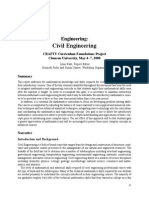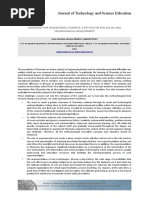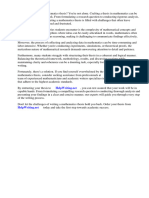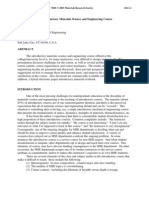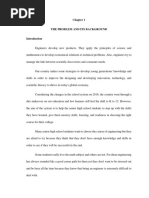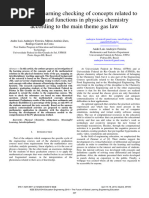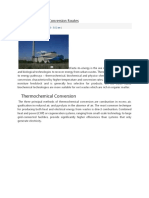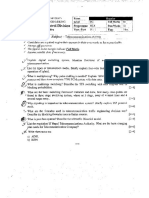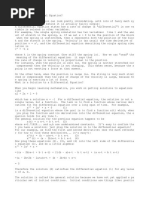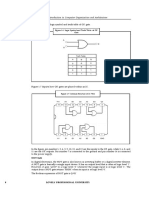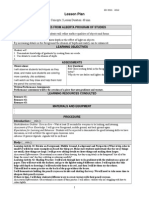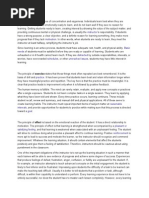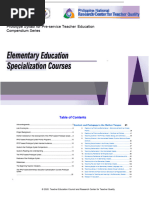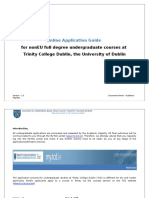Engineering Statistical Needs and Engineering Curriculum: An Analysis
Engineering Statistical Needs and Engineering Curriculum: An Analysis
Uploaded by
BineilKcThapaCopyright:
Available Formats
Engineering Statistical Needs and Engineering Curriculum: An Analysis
Engineering Statistical Needs and Engineering Curriculum: An Analysis
Uploaded by
BineilKcThapaOriginal Description:
Original Title
Copyright
Available Formats
Share this document
Did you find this document useful?
Is this content inappropriate?
Copyright:
Available Formats
Engineering Statistical Needs and Engineering Curriculum: An Analysis
Engineering Statistical Needs and Engineering Curriculum: An Analysis
Uploaded by
BineilKcThapaCopyright:
Available Formats
ICOTS-7, 2006: Fernndez de Carrera
ENGINEERING STATISTICAL NEEDS AND ENGINEERING CURRICULUM:
AN ANALYSIS
Elena T. Fernndez de Carrera
National Technological University/Litoral National University, Argentina
ecarrera@arnet.com.ar
The importance of statistical science in engineering education is a subject that no longer merits
discussion. The constructivist approach in its teaching, the need to teach using problem solving,
and the contribution of modern technologies to optimize this learning are accepted facts by most
statistics professors. In this paper we analyze the problems present in Argentina and other
countries related to WHAT is the content of the subject?, To WHAT extent do they go?, and
WHEN in the core curricula, is the content included? We also analyze whether to have one
course with the same content for all the engineering majors or to adapt content to the specific
needs in each of area. In this mixture of uncertainties, statistics is presented like an enigma to the
students of engineering, especially if statistics is taught in the early stages of their program. This
happens in Argentina where the roles of statistics in engineering are very difficult to demonstrate
because students have only taken basic subjects like mathematics, physics or biology.
INTRODUCTION
Todays probability and statistics are in most engineering curricula in many countries.
Nobody doubts nowadays that all professionals should be qualified to design an investigation,
gather data with previous planning and analyze the results (Fernndez de Carrera, 2002).
If the needs of themes related to statistics within the engineering careers are analyzed
considering the advancement of the professionals future career, none of their content would be
inappropriate. Data analyses, experimental design, risk / survival analyses and theoretical
concepts like stochastic processes are necessary in solving more than one current engineering
problem, and in certain cases, some of them are needed to a greater extent according to the
specialty.
The importance of using statistics to measure the product variability in each area of
engineering has been extensively discussed. To continue competing in different markets, the
industry should improve the product and service quality. The effort in this improvement should be
done by engineers and scientists as well given the fact that they are the ones involved in the
design to develop new products and to improve the ones already existing.
Education is one of the major worries in the societies of the First World countries. It is
said that Argentina is also worried about this situation even though the low Gross National
Product percent investment in Education seems to deny this affirmation.
The speed knowledge is growing nowadays makes the information that had been
previously acquired be scarce and obsolete. Therefore, this dynamic requires a permanent
updating. Statistics is considered not only one of the fundamental methodological sciences but
also the basis of the experimental scientific method, helping the students personal growing and
encouraging their critical reasoning based in giving importance to the objective evidence
(Batanero, 2002). Furthermore it is important to emphasize the need to think statistically and to
further its studies, adding the statistical science contents to the core curricula of the different
engineering areas (Davies, 2001). Even if the still to be discussed Parry-Jones (1999), cited by
Davies (2001), innovative and radical way of teaching statistics is adopted, there still exists a
question to be clarified Is it necessary to teach the same program in all the engineering areas?
Do the engineering fields like the ones involved in design, or the others related with electricity
and electronics, including mechanical engineering, civil and even the biological ones need the
same knowledge? For example, are stochastic processes and all the theoretical side of the theory
of probabilities, like combined distributions, moments, distributions of the addition and other
properties, really needed in all the specialties?
To reach the objective mentioned, a course on theory of the probabilities is very much
needed. Thus, another question arises, is it necessary to include all the Methodology of Statistics?
Though the idea of what a basic course in statistics should be depends basically on the professor
ICOTS-7, 2006: Fernndez de Carrera
in charge of the subject, I agree with Montgomery and Runger (1996) on the fact that a first level
course on statistics for engineers should be principally a course on Applied Statistics, and not a
course on Theory of Probabilities and its applications. Many years of experience and thinking
about questions, plus the fact that as time goes by they become more and more complex given the
rapid growth of knowledge, lead me to share these reflections.
The objective of this paper is precisely to bring into consideration the still unsolved
problem - mainly in Argentina, my country- related to what the course contents are, up to what
extensions they should be developed and whether these contents are to be included in the core
curricula? I believe that this is the appropriate moment to make the change. The Ministry of
Educations authorities have created a National Master Program involving all the different State
Schools/Faculties of Engineering. The Program for the Improvement of the Teaching Process in
Engineering (PROMEI, in Spanish) has to do with the necessary modifications to improve the
careers of Engineering in all the specialties. This Program is based on the fact that when
evaluating the careers/professional skills/abilities/quality, the results were not quite satisfactory.
ENGINEERING CORE CURRICULA
Much of the recent discussion about the contents of the first course in Statistics was
related to considering Statistics as a discipline, with emphasis on problem-solving skills and
teaching and learning one form of viewing the reality, with a particular emphasis in
interdisciplinary work.
In general, the accreditation processes of engineering studies need to assess not only their
graduates but also their professors qualities/skills/abilities. Yet, it is necessary to state in detail
what those qualities-skills/abilities are.
Dansie (2005) says that the University of South Australia states that its graduates will
have the ability to work with and upon a body of knowledge, to engage in lifelong learning, to be
effective problem solvers and communicators, to work autonomously and collaboratively, to be
committed to ethical action and social responsibility and to demonstrate international perspective.
I believe these to be the minimum abilities/skills qualities each universitys graduate from
a school of engineering should have, plus those specific skills each Institution considers necessary
to add in order for a student to be granted a degree.
In the core curriculum design, the graduates qualities like Institutional values play an
important role too. Furthermore, each different engineering field, like bioengineering,
biotechnology, food engineering, needs not only a basic course in statistics but also one in
learning experimental design, one/two way analysis of variance, parametric or non parametric
methods, multivariate analysis, general linear models, procedures among other subjects in order
to fulfill the graduates minimum requirements in these specific specialties when having to face
their future profession.
Stochastic Processes and Theory of Probability are areas that should not be left aside in
different engineering fields such as Electronics in Communicational Engineering, or in those
fields that have to do with Informatics or Computer Technology. These are not only necessary to
further develop as professionals but also to understand more advanced subjects in the career of
the students choice.
CREDIT HOUR REQUIREMENTS
Currently there is an undergoing research on the contents of Mathematics throughout all
the State Schools/Faculties where some of the many different areas of engineering are taught so
as to analyze their similarities and differences. In almost all of them there appears to be only one
course in Probability and Statistics is taught, yet in some Schools, mainly in those where the
engineering is related to Electronics, Communications or Computation, this elemental course is
followed by another on Probability and Stochastic Processes. However, in some Schools/Faculties
both courses combine to form only one. In 80% of the cases the credit hour requirement assigned
to those courses results in approximately 70 to 80 class hours in the semester. This gives rise to
the question: Is it possible to achieve anything in that short time? Evidently, before this question,
it is necessary to find an answer to Which are the abilities, skills and knowledge the student had
before beginning high studies?
ICOTS-7, 2006: Fernndez de Carrera
I also agree with MacGuillivray (2001) regarding the concept that in Argentina also the
school scene is generally characterized by the acknowledgement of the importance of Chance
and Data but also by the significant absence of knowhow and resources to support this, and
sometimes even to identify what could or should be done.
PREVIOUS CONDITIONS
The past decade has seen a serious decline in students basic mathematical skills and level
of preparation on entry into higher education, thus causing many students to embark on
engineering degree programs without the necessary maths skills required for the course.
During 1994, in Argentina, a reform in the educational system was produced. Primary
and secondary traditional teaching was modified into Basic General Teaching (EGB, in Spanish)
and Polimodal Education. Attending school is mandatory until finishing the third stage of Basic
General Teaching (EGB 3), being 14 years of age on average It is no longer mandatory for
students to attend the Polimodal stage. It is considered that these mathematical problems have
increased and worsened and it is also understood that they have arisen from a number of factors
including:
Widening of access to higher education resulting in the acceptance of students with
much more diverse backgrounds and experiences of mathematics than previously.
Inadequate mathematics preparation in pre-18 education- due to a variety of causes
including curriculum shortcomings, not enough emphasis on assessment and shortage
of mathematically qualified teachers, and social influences.
Unfortunately, this situation is worse with regard to the Statistical Sciences.
From this reform onwards, contents involved with data management (frequency
counting), and graphics interpretation (bars, pies and pictograms charts) were introduced from the
first EGB cycle to Polimodal Education level where Probability as well as Distribution
Probability are to be completed. Stochastic thinking has arrived at all levels of the educational
curricula. Twelve years have elapsed during which there existed the possibility of incorporating
these subjects and confronting students with the concept of uncertainty so frequent to all citizens
that even all forms of communication use it. So the question arises Does the school prepare
him/her to do it? This happens not only in Argentina but also in many countries around the world,
where education has to meet this challenge in the last years. The need for mathematically literate
students who can function in today's technological society has promoted a change in the content
of the mathematics core curriculum (Starkings, 1997; Fernndez de Carrera, 2002).
This may be due to diverse causes, among them the lack of concise and clear concepts, or
maybe to deficiencies in their careers, or it could be that these concepts had not been taught
before or had been forgotten. In general teachers, like students, acquire some of their statistical
background from informal sources. Statistics teachers often lack adequate foundation in this
science or perhaps they may even lack the adequate training to teach it.
Results obtained show that students come to the first university courses on Statistics and
Probability with almost no systematic knowledge of probability elemental concepts. Though they
have developed intuition, making use of it sometimes, we infer that middle school teaching does
not prepare them to face several problems concerning these concepts and specially the one
referring to uncertainty (Fernndez de Carrera, 2002).
THE NEED TO WORK ON PROBLEM SOLVING
The teaching of Statistics does not have its own theory. Consequently, it is suggested to
interpret it from the point of view of those sciences/subjects that belong to mathematics education
and that do have developed theories. (Garfield, 1995; Ottaviani, 1999; Batanero, 2001). The
theories on the education of mathematics are based on those epistemological positions that
consider it as a construction of the human being, tending to satisfy his/her needs and to solve
problems in different areas, including those related to every day life. Consequently, the problems
and their solutions are presented like the very best situation in the task of teaching statistics. The
resolution of problems is adapted from the constructivist approach as a theory of learning, helping
the student in the solving of the proposed problems. While searching for the solution, the
ICOTS-7, 2006: Fernndez de Carrera
participants need to expand their knowledge, analyze a particular situation, design an experience,
collect data, verify their hypothesis and generalize their results.
The acquisition of the statistical thought or statistical reasoning we are proposing has
recently been conceived. Consequently, this position and asking oneself What is the statistical
thought? has resulted in recent research like the one from Wild and Pfannkuch (1999) that
distinguished five fundamental components in this reasoning: to acknowledge the need of data
(quantify), what evolves from these data (exploratory analysis), to perceive the variation or
variability, to find a model and to integrate the statistics to the context of the problem. Each one
of these five components is important, yet the first three are the foundation that each citizen
should have and that anyone who has a position that involves a decision making situation in the
society should know unless he or she is unable to exercise his/her obligations. Therefore, to learn
statistics is not to learn how to make numbers or to acquire one more outstanding capacity to use
statistical software. Nowadays, its easy access leads to its indiscriminate use without considering
all its potential and the needed requirements to know how to use a specific test. Consequently,
there has been a spontaneous appearance of a number of experts, without any statistical
formation who dare to reach a conclusion just because they are skilful in working with specific
software, making inferences without any theoretical support.
Computing technology has expanded its possibility and learners and teachers have greater
accessibility to it. It is mandatory to integrate the PC to the class of statistics using demonstrations
and visualizations, to enhance both skill and conceptual development. Evidently there is a before
and after in the teaching of this subject directly related with the presence of the Personal
Computer. Due to its presence, it is possible in our classes to allow the student to acquire ways of
thinking with less time in tedious calculations - a situation that would be difficult to overcome
without the presence of the informatics technology.
In our Institutions, the first courses in statistics will focus on developing the statistical
thinking, problem solving and the probability as a way to measure uncertainty. What is more, in
our courses we show the students the way they could use statistics to solve problems related to
engineering or to technology. To do so it is necessary to include real problems that are to be taken
from specific publications or that are real facts that have to be processed and were presented by
professors from other subjects in the career. All this process requires the ability to integrate a
range of skills, knowledge and attitudes into strategies to overcome this complex situation.
CONCLUSION
There are too many questions, many of them with various answers. Probably, from their
discussion it is possible to reach a solution. It is my opinion that with the credit hour requirement,
a basic course in Methodological Statistics is top priority. Furthermore, a course in Theory of
Probabilities and Stochastic Processes and their applications are also important to be included as a
part of continuing education courses or courses in parallel to the core curriculum of the different
engineering or technological careers that need them. It is also important to offer a second course
oriented to the different engineering fields in order to provide the future professionals with a
minimum knowledge on Statistics science. This should allow them to become a skilful and
intelligent user of the statistics, to be part of interdisciplinary teams with other professionals,
among them statisticians, with the objective of solving the complex problems that have to do with
todays reality.
REFERENCES
Batanero, C. (2001). Presente y futuro de la educacin Estadstica. Dpto. de Didctica de la
Matemtica de la Universidad de Granada.
Batanero, C. (2002). Los retos de la cultura Estadstica. Jornadas internacionales de Enseanza de
la Estadstica. Buenos Aires. Conferencia inaugural.
Cox, B., Bidgood, P., and Goldfinch, J. (2001). Progress on Where are we now project. MSOR
Conections, 1(4), 10 11.
Dansie, B. (2005). The role of statistical education in developing graduate qualities. MSOR
Connections, 5(3), 1-4.
Davies, N. (2001). A new way to teach statistics to engineers. MSOR Connections, 1(2), 7-9.
ICOTS-7, 2006: Fernndez de Carrera
Fernndez de Carrera, E. T. (2002). Teaching statistics in secondary school: An overview. In B.
Phillips (Ed.), Proceedings of the Sixth International Conference on Teaching of Statistics,
Cape Town. Voorburg, The Netherlands: International Statistical Institute.
Gal, I. and Garfield, J. (1997). Curricular goals and assessment challenges in Statistics Education.
In I. Gal and J. B. Garfield (Eds.), The Assessment Challenge in Statistics Education, (pp. 113). Amsterdam: IOS Press and the International Statistical Institute.
Garfield, J. (1995). How students learn statistics. International Statistical Review, 63 (1), 25-34.
MacGillivray, H. L. (2001). Statistics education downunder: A snapshot of a decade and a glance
to the future. MSOR Connections, 1(4), 11 14.
Montgomery, D. and Runger, G. (1996). Probabilidad y estadstica aplicada a la ingeniera.
Mxico: McGraw-Hill.
Ottaviani, M. G. (1999). Notas sobre los desarrollos y perspectivas en Educacin
Estadstica. Conferencia inaugural de CLATSE V (V Congreso Latinoamericano de
Sociedades de Estadstica). Mendoza, Argentina.
Starkings, S. (1997). An international overview of dates analysis within the mathematics
curriculum. Papers on Statistical Education, (pp. 7-13). Swinburne University of
Technology: IASE.
Wild, C. and Pfannkuch, M. (1999). Statistical thinking in empirical enquiry (with discussion).
International Statistical Review, 67(3), 223-265.
You might also like
- Hodder Assessment WEBDocument40 pagesHodder Assessment WEBvitoavNo ratings yet
- PalmisrDocument61 pagesPalmisrBineilKcThapaNo ratings yet
- The Different PersonalitiesDocument10 pagesThe Different Personalitiesanjap6No ratings yet
- Statistics in Civil EngineeringDocument8 pagesStatistics in Civil EngineeringdebasisdgNo ratings yet
- Program Assessment Linked 021815 RedDocument677 pagesProgram Assessment Linked 021815 Redapi-273444219No ratings yet
- Ac 2012-5124: Real-World Applications of Mathematical and Scientific Principles in The Curriculum For College and Career SuccessDocument13 pagesAc 2012-5124: Real-World Applications of Mathematical and Scientific Principles in The Curriculum For College and Career SuccessGrahsie Abella Paño-GuertaNo ratings yet
- Developing Technology Teachers: Questioning The Industrial Tool Use ModelDocument13 pagesDeveloping Technology Teachers: Questioning The Industrial Tool Use ModelDevi Byun ChannieNo ratings yet
- Undergraduate 14Document22 pagesUndergraduate 14Thakur Aryan SinghNo ratings yet
- Journal of Technology and Science EducationDocument16 pagesJournal of Technology and Science EducationVallimanalan AsokanNo ratings yet
- PrincipleDocument11 pagesPrincipleNaila syabina RachmiNo ratings yet
- As Und ADocument17 pagesAs Und AMotamnyt AlgnaNo ratings yet
- ResearchDocument6 pagesResearchlee nicolasNo ratings yet
- Incorporating Engineering Applications Into Calculus InstructionDocument11 pagesIncorporating Engineering Applications Into Calculus InstructionRita VazquezNo ratings yet
- May ResearchDocument29 pagesMay ResearchRicka MhaeyNo ratings yet
- Journal of Technology and Science EducationDocument3 pagesJournal of Technology and Science EducationCharity BakhoyaNo ratings yet
- Sample Paper 1Document6 pagesSample Paper 1Darleen Joy UdtujanNo ratings yet
- PAEE ALE 2018 Artigo 127 ReviewedDocument10 pagesPAEE ALE 2018 Artigo 127 ReviewedLilian CamposNo ratings yet
- Mathematics Thesis TitleDocument5 pagesMathematics Thesis Titlegbtrjrap100% (2)
- Local StudiesDocument12 pagesLocal StudiesJohn Christopher PalacioNo ratings yet
- Joceil Vicentuans Group Undergraduate ThesisDocument21 pagesJoceil Vicentuans Group Undergraduate ThesisJohn Michael PerezNo ratings yet
- Chapter I-Corrected With GrammarlyDocument13 pagesChapter I-Corrected With GrammarlyJalil BenitoNo ratings yet
- Static Slide in Mathematics ResearchDocument1 pageStatic Slide in Mathematics ResearchJonel ValdezNo ratings yet
- PR2 G2 AutosavedDocument16 pagesPR2 G2 AutosavedOni GiriNo ratings yet
- Foreign Related LiteratureDocument4 pagesForeign Related LiteratureJames Andrew ArañezNo ratings yet
- Linking Mathematics and Image Processing Through Common TerminologiesDocument10 pagesLinking Mathematics and Image Processing Through Common TerminologiesThammie Christy SaibinNo ratings yet
- Calculus Students Use of Figures and Graphs in Technical Report WritingDocument7 pagesCalculus Students Use of Figures and Graphs in Technical Report WritingDaniella Jane AmistadNo ratings yet
- Using Data Mining To Predict Secondary School Student PerformanceDocument9 pagesUsing Data Mining To Predict Secondary School Student PerformanceNoviyanti Tri Maretta SagalaNo ratings yet
- هندسة المناهج التعليميةDocument142 pagesهندسة المناهج التعليميةMarouen Ben AbdallahNo ratings yet
- Castro Chapter IDocument8 pagesCastro Chapter INicolette Yvonne CastroNo ratings yet
- First Year Students Are Known To Struggle With The Different Learning Contexts at School and UniversityDocument2 pagesFirst Year Students Are Known To Struggle With The Different Learning Contexts at School and Universityjoyann pasigonNo ratings yet
- The Introductory Materials Science and Engineering CourseDocument10 pagesThe Introductory Materials Science and Engineering CourseAulia KhairNo ratings yet
- An Assessment of Theory of Computation in Computer Science CurriculaDocument12 pagesAn Assessment of Theory of Computation in Computer Science CurriculajohnNo ratings yet
- Student's InclinationDocument4 pagesStudent's InclinationCorey PageNo ratings yet
- Add-On Subjects in Science Special Program-Science, Technology, Engineering (STE) : Its Impact in Choosing A Career in STEMDocument4 pagesAdd-On Subjects in Science Special Program-Science, Technology, Engineering (STE) : Its Impact in Choosing A Career in STEMInternational Journal of Innovative Science and Research TechnologyNo ratings yet
- Chapter 1 Thesis Significance of The StudyDocument7 pagesChapter 1 Thesis Significance of The Studyaflnzraiaaetew100% (2)
- Cesar 2017Document52 pagesCesar 2017Syaeful MalikNo ratings yet
- DTM1 Galbraith (2006)Document8 pagesDTM1 Galbraith (2006)4qvqj9z85qNo ratings yet
- International JournalDocument14 pagesInternational JournalFirda Annidaul KhusnaNo ratings yet
- 123 Accounting Research MethodDocument5 pages123 Accounting Research Methoddedalyn09No ratings yet
- Current Status and Outlook of Computational Materials Science Education in The USDocument17 pagesCurrent Status and Outlook of Computational Materials Science Education in The USsrokkamNo ratings yet
- ACTION RESEARCH ABOUT Technical SkillsDocument21 pagesACTION RESEARCH ABOUT Technical Skillsjasleh ann villaflorNo ratings yet
- Quantitative of Ross Mathew Oropilla CH 1-5Document145 pagesQuantitative of Ross Mathew Oropilla CH 1-5nailyn ronquilloNo ratings yet
- Adjusting Higher Education Competences To Companies Professional Needs:: A Case Study in An Engineering Master's DegreeDocument5 pagesAdjusting Higher Education Competences To Companies Professional Needs:: A Case Study in An Engineering Master's DegreeTesis LabNo ratings yet
- Newhouse2017 Article STEMTheBoredomEngageStudentsInDocument14 pagesNewhouse2017 Article STEMTheBoredomEngageStudentsInI Wayan RedhanaNo ratings yet
- IntroductionDocument11 pagesIntroductionbillyjaycruz02No ratings yet
- Building Bridges Between Math and Enginnering PDFDocument20 pagesBuilding Bridges Between Math and Enginnering PDFKent Benedict Pastolero CabucosNo ratings yet
- Independent Research Project The Direction of Career and Technology Education in The 21 Century EDU 600 Andrew Borriello University of New EnglandDocument9 pagesIndependent Research Project The Direction of Career and Technology Education in The 21 Century EDU 600 Andrew Borriello University of New Englandapi-290593844No ratings yet
- Development of A Scale For Measuring Students' Attitudes Towards Learning Professional (I.e., Soft) SkillsDocument17 pagesDevelopment of A Scale For Measuring Students' Attitudes Towards Learning Professional (I.e., Soft) SkillsHuyen Thu NguyenNo ratings yet
- christopoulos-et-al-2020-limits-and-virtues-of-educational-technology-in-elementary-school-mathematicsDocument23 pageschristopoulos-et-al-2020-limits-and-virtues-of-educational-technology-in-elementary-school-mathematicsDiego AyalaNo ratings yet
- StemDocument3 pagesSteme.jamitoNo ratings yet
- Sigcse Bulletin: Vol 2 8 N o - 2 J U N e 1 9 9 6Document8 pagesSigcse Bulletin: Vol 2 8 N o - 2 J U N e 1 9 9 6Zubair AzizNo ratings yet
- 2010S02F04جديدDocument6 pages2010S02F04جديدasamaskeirNo ratings yet
- Chung2016 Article InfluenceOfProblem-basedLearni PDFDocument23 pagesChung2016 Article InfluenceOfProblem-basedLearni PDFAsria g. PandaratNo ratings yet
- Archives Attach 106Document26 pagesArchives Attach 106kellygloriaNo ratings yet
- Teaching and Learning in STEM With Computation, Modeling, and Simulation Practices: A Guide for Practitioners and ResearchersFrom EverandTeaching and Learning in STEM With Computation, Modeling, and Simulation Practices: A Guide for Practitioners and ResearchersNo ratings yet
- PHD Thesis in Mathematical Statistics PDFDocument5 pagesPHD Thesis in Mathematical Statistics PDFkimberlyjonesshreveport100% (2)
- Defintion of Stem LiteracyDocument16 pagesDefintion of Stem LiteracyMs EuphraxiaNo ratings yet
- Case Study To Analyze The Impact of Multi-CourseDocument21 pagesCase Study To Analyze The Impact of Multi-CourseMiriam CollegeNo ratings yet
- ES - Models - OverviewDocument3 pagesES - Models - OverviewMr. RobotNo ratings yet
- Term Paper About Educational TechnologyDocument4 pagesTerm Paper About Educational Technologyafdtrajxq100% (1)
- 1661-Texto Del Artículo-4851-1-10-20121011 PDFDocument13 pages1661-Texto Del Artículo-4851-1-10-20121011 PDFMateo Gutierrez MeloNo ratings yet
- Imrad Research Format 1 AutorecoveredDocument30 pagesImrad Research Format 1 AutorecoveredDave Libres Enterina60% (5)
- Teaching College-Level Disciplinary Literacy: Strategies and Practices in STEM and Professional StudiesFrom EverandTeaching College-Level Disciplinary Literacy: Strategies and Practices in STEM and Professional StudiesJuanita C. ButNo ratings yet
- Chapter 1: Introduction: Kobid Karkee Kobidkarkee@kec - Edu.np Kantipur Engineering College Dhapakhel, LalitpurDocument28 pagesChapter 1: Introduction: Kobid Karkee Kobidkarkee@kec - Edu.np Kantipur Engineering College Dhapakhel, LalitpurBineilKcThapaNo ratings yet
- BitLocker Recovery Key 7B846EEC 12B8 4A39 8CB7 1619643B3508Document1 pageBitLocker Recovery Key 7B846EEC 12B8 4A39 8CB7 1619643B3508BineilKcThapaNo ratings yet
- Digital Signal Processing EX 753: Lecture: 3 Year: IV Tutorial: 1 Part: II Practical: 1.5Document1 pageDigital Signal Processing EX 753: Lecture: 3 Year: IV Tutorial: 1 Part: II Practical: 1.5BineilKcThapaNo ratings yet
- Wireless Communications EX 751: Lecture: 3 Year: IV Tutorial: 0 Part: II Practical: 1.5Document1 pageWireless Communications EX 751: Lecture: 3 Year: IV Tutorial: 0 Part: II Practical: 1.5BineilKcThapaNo ratings yet
- In Brief HereDocument3 pagesIn Brief HereBineilKcThapaNo ratings yet
- FeasibilityDocument1 pageFeasibilityBineilKcThapaNo ratings yet
- Bexq Iv IDocument86 pagesBexq Iv IBineilKcThapaNo ratings yet
- What Is Differntial EquationDocument2 pagesWhat Is Differntial EquationBineilKcThapaNo ratings yet
- Project Management: B.E. Tribhuwan University, IOEDocument15 pagesProject Management: B.E. Tribhuwan University, IOEBineilKcThapaNo ratings yet
- Untitled 1Document1 pageUntitled 1BineilKcThapaNo ratings yet
- Project EX/CT : Lecture: 0 Year: IV Tutorial: 0 Part: I Practical: 3Document1 pageProject EX/CT : Lecture: 0 Year: IV Tutorial: 0 Part: I Practical: 3BineilKcThapaNo ratings yet
- Organization and Management MEDocument1 pageOrganization and Management MEBineilKcThapaNo ratings yet
- 1.Y L (XKL: T KT TDocument1 page1.Y L (XKL: T KT TBineilKcThapaNo ratings yet
- G) KFN LJB'T K - Flws/0Fsf) : NF) 8 ) L8Ë KL/JT (G Dagwl "RGFDocument1 pageG) KFN LJB'T K - Flws/0Fsf) : NF) 8 ) L8Ë KL/JT (G Dagwl "RGFBineilKcThapaNo ratings yet
- Notes: Computer Organization and Architecture/Introduction To Computer Organization and ArchitectureDocument1 pageNotes: Computer Organization and Architecture/Introduction To Computer Organization and ArchitectureBineilKcThapaNo ratings yet
- Computer Standards and ProtocolsDocument2 pagesComputer Standards and ProtocolsBineilKcThapaNo ratings yet
- November 05 V MSDocument3 pagesNovember 05 V MSVarun PanickerNo ratings yet
- High School Student Resume ExampleDocument2 pagesHigh School Student Resume ExampleDanisha IrmaNo ratings yet
- Kaitlyn Harris ResumeDocument2 pagesKaitlyn Harris Resumeapi-276671806No ratings yet
- RRLDocument3 pagesRRLVan Santos100% (2)
- Math Interaction Project Reflection PaperDocument18 pagesMath Interaction Project Reflection Paperapi-302632598No ratings yet
- Curriculum PPT 2011Document145 pagesCurriculum PPT 2011Gudina Merdasa0% (1)
- Art Lesson Three ColouringDocument2 pagesArt Lesson Three Colouringapi-266876368No ratings yet
- Fundae Sundaes. Excel It! 2E - Student WorkbookDocument3 pagesFundae Sundaes. Excel It! 2E - Student WorkbookWinveilNo ratings yet
- Looking Back Looking Forward ReflectionDocument9 pagesLooking Back Looking Forward Reflectionapi-237415788No ratings yet
- Instructor Motivation: Readiness Implies A Degree of Concentration and Eagerness. Individuals Learn Best When They AreDocument3 pagesInstructor Motivation: Readiness Implies A Degree of Concentration and Eagerness. Individuals Learn Best When They AreMichelle Jeanne DenoreNo ratings yet
- AICTE Sponsored National Seminar On Recent Trends in Embedded Systems National Seminar On Recent Trends in Embedded SystemsDocument2 pagesAICTE Sponsored National Seminar On Recent Trends in Embedded Systems National Seminar On Recent Trends in Embedded SystemsdeepakNo ratings yet
- 7th Grade Module 1 Lesson 6Document5 pages7th Grade Module 1 Lesson 6api-369302912No ratings yet
- Instructional Design Models and MethodsDocument8 pagesInstructional Design Models and MethodsJoshua Rosenbaum100% (1)
- 3 Elementary Education Prototype Syllabi CompendiumDocument171 pages3 Elementary Education Prototype Syllabi Compendiumjohnnyboy.galvanNo ratings yet
- Budget Proposal School MiscellaneousDocument9 pagesBudget Proposal School MiscellaneousRomnick PortillanoNo ratings yet
- To Increase Writing Skills Using Capital Letter For Year Five Students at SJKC Khoi Ming, Kota Marudu in The Beginning of Sentence and Proper NounsDocument8 pagesTo Increase Writing Skills Using Capital Letter For Year Five Students at SJKC Khoi Ming, Kota Marudu in The Beginning of Sentence and Proper NounsClarence de GuzmanNo ratings yet
- Resume 2018Document1 pageResume 2018api-355955362No ratings yet
- Online Application Guide: For Noneu Full Degree Undergraduate Courses at Trinity College Dublin, The University of DublinDocument37 pagesOnline Application Guide: For Noneu Full Degree Undergraduate Courses at Trinity College Dublin, The University of DublinAnonymous Yl49QjvnmnNo ratings yet
- IELTSDocument2 pagesIELTSDefprimal0% (1)
- MP Prayer LetterDocument3 pagesMP Prayer Letterthunder2107No ratings yet
- 0580 - w10 - Ms - 41 MathDocument6 pages0580 - w10 - Ms - 41 MathKhaled SaidNo ratings yet
- Book Index With Reviews. EBSCO. Web. 14 Dec. 2010Document8 pagesBook Index With Reviews. EBSCO. Web. 14 Dec. 2010api-166902455No ratings yet
- Liphardt ResumeDocument4 pagesLiphardt Resumeapi-398834878No ratings yet
- Top Notch 3 Lesson 5Document5 pagesTop Notch 3 Lesson 5Oscar ReyesNo ratings yet
- Manual of Naac For Affiliated CollegesDocument89 pagesManual of Naac For Affiliated CollegesIndurElectricalsNo ratings yet
- FS 1 Observation of Teaching Learning in Actual SchoolDocument9 pagesFS 1 Observation of Teaching Learning in Actual SchoolJayvee R Rosopa100% (1)
- Reflective Lesson PlanDocument6 pagesReflective Lesson PlanstraitmiNo ratings yet



